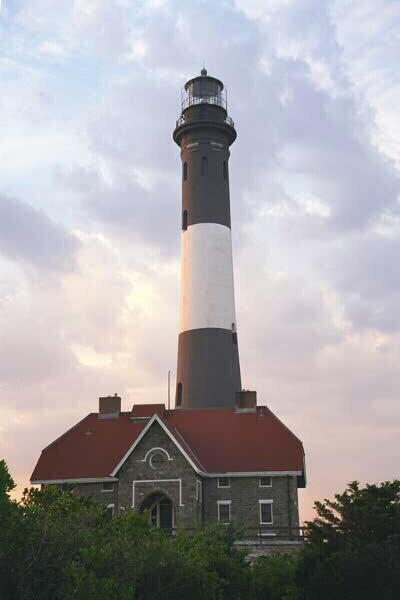

Constructed in 1872, this light is located at the entrance to Provincetown Harbor, on Cape Cod, Massachusetts. The 39 foot tower and adjacent oil house are built of brick. The tower has a focal plane 45 feet above sea level. A modern optic replaces the fifth-order Fresnel lens which previously served here. This light continues to serve mariners, flashing red once every ten seconds.
Established in 1890, this light is located on the eastern approach into Narragansett Bay near Newport, Rhode Island. The squat 34 foot tower is constructed of granite and originally housed a fifth-order Fresnel lens. Automated in 1957, this light is still active, displaying a six second red flash followed by six seconds of dark.
One of the most photographed lighthouses in Maine, Bass Harbor Head light was put into service in 1858. The station consists of a white brick tower and attatched keeper's house perched on the western rocks of Mount Desert Island. The tower still contains its fourth-order Fresnel lens. Displaying an occulting red light, Bass Harbor Head Light continues to guide lobster boats into Bass Harbor.
Cape Hatteras is, quite possibly, the most famous aid to navigation in the world. Its spiraling black and white bands, unique red base, and massive height make Hatteras one of America's most notable landmarks. Constructed on North Carolina's Outer Banks in 1803, the first light at Hatteras was not tall enough to be seen from the shoals it was intended to guard. Diamond Shoals is a deadly line of shallows lurking off Cape Hatteras, formed by the convergence of the Labrador Current and the Gulf Stream. The original Hatteras light was dubbed one of the worst lights in America, and, in 1870, was replaced by the current 193 foot brick tower-America's tallest brick lighthouse.
In recent years, great concern had been raised over the continued encroachment of the sea on Cape Hatteras. The beach had eroded right up to the base of the great tower. And with each passing storm, it was feared the light might crumble into the sea. In 1999, however, Cape Hatteras Light was saved. The tower was carefully jacked up and slowly moved inland, sparing the great light from the creeping tides and encroaching seas. Now, Cape Hatteras Light will be safe for many generations and will continue to send its lifesaving beam to sea.
The first Fire Island Lighthouse was completed in 1826 on the western end of Fire Island, a 32-mile barrier island stretching south of Long Island. The tower, a near twin to the one at Montauk Point, proved to be inadequate. Only 74-feet in height, the tower was not tall enough to give mariners ample warning of the nearby shoals. In 1858, the 180-foot brick tower seen today, replaced the original, less effective light. A first-order Fresnel lens was installed, making the light visible from a distance of nearly twenty-five miles.
The light was decommissioned by the Coast Guard in 1974, and after years of neglect, was beginning to crumble. In 1982, the Fire Island Lighthouse Preservation Society was established to raise funds for the restoration of the light. The tower and grounds have since been restored and the light relit. Now the Fire Island Lighthouse continues to shine, but with a new purpose, as a tourist attraction, interpretive tool, and inspiration to all those who visit this beautiful seashore.
Located on Thatcher Island off Cape Ann, Massachusetts, the first light station here dates back to 1771. A set of two light towers was constructed in an attempt to distinguish Cape Ann from other nearby light stations. In 1861, the old 45-foot towers were replaced by the current 124-foot granite towers seen today. In 1932, the Coast Guard removed the first-order Fresnel lenses from both towers and deactivitated the north tower. Today, only the south tower is in use, displaying a red flash.
One of several lights on the lower Kennebec River, this light was constructed in 1898 on Arrowsic Island, near Bath, Maine. Intended to mark a treacherous bend in the river, the small octagonal tower had to be moved onto a pier just offshore to be more effective. In 1902, the tower received a fifth-order Fresnel lens. In 1988, the tower was automated and its lens replaced with a modern optic. The light remains active, flashing white once every four seconds.
Also located on Arrowsic Island, Squirrel Point's 25-foot wooden tower and keeper's house were completed in 1898. A fifth-order Fresnel lens was later installed. Automated in 1979, the lens was removed and replaced by a modern optic. The light remains in use, flashing red for six seconds followed by six seconds of dark.
 |
FIRE ISLAND LIGHT |  |